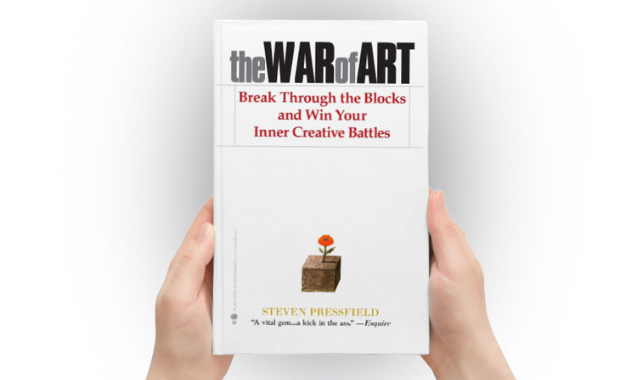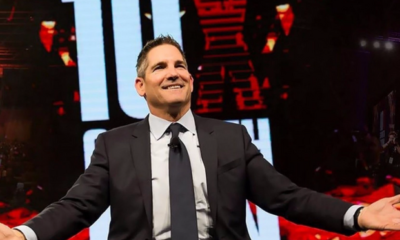Life
Life Lessons From The War of Art That Will Change Your Life

Life is chock full of both good and bad experiences. But, when times are hard, it’s, unfortunately, a natural reaction to revert into yourself as you take on the blows that life has dealt you. However, with that said, there is one simple truth that I’ve tried to stand by over the years. Instead of hiding away from the world during the tough times, always take a second to reflect on what got you to that position in the first place.
Whether you’ve made a mistake, or something has happened that you couldn’t control, you should try to be grateful all the same. When you experience these setbacks in life, it means you’ve actively made a decision to put yourself on the line – whether that’s emotionally, financially, or physically.
Believe me, you’ll sleep much better at night in the knowledge that you’ve made the decision to actively participate in life rather than watch from the sidelines as others achieve their calling. This is something that I learned early on in my entrepreneurial career from a little book called “The War of Art: Break Through the Blocks and Win Your Inner Creative Battles” by Steven Pressfield.
The author explains that the modern professional should never be under any illusion that achieving your potential is full of challenges, inequality, hardship, and lucky breaks (both good and bad).
The book is divided into three sections; the first introduces and describes the force that keeps us from achieving our calling “Resistance”; the second teaches us how to combat this invisible foe, and the third teaches us how to move past Resistance.
Here are some of the most important lessons I’ve learned from keeping this book close to hand.
1. Embrace Fear
Resistance feeds on fear. We all feel fear in the face of resistance, but so many of us just aren’t able to conquer it. Pressfield writes that fear is actually a pivotal moment in our journey; in other words, you either continue along the path you’re on, or you turn around and head for home. The more fearful you are of something, the more it means to you, and the more it has the potential to change your life.
By conquering these fears, the better and stronger you become. For example, back in 2016, an interviewer for The Verge asked the actor Tom Hiddleston why he had taken on the role of legendary country music star Hank Williams, he replied: “because it scared me.”
In most cases, the more significant a risk you take, the bigger the reward. In fact, the only real risk in life is being too afraid to take any at all.
“Our job in this life is not to shape ourselves into some ideal we imagine we ought to be, but to find out who we already are and become it.” ― Steven Pressfield
2. Live Your Best Life
Most of us lead two parallel lives: the one that we live now, and the one which we are too afraid to reach out and grasp for.
This could apply to just about any walk of life; for example, perhaps are you a budding entrepreneur crippled by fear of failure? A novelist afraid of the blank sheet of paper, or an artist who can’t pick up the brush? If you can see a life on the other side of the tracks, which you’re too afraid to live then you’re suffering from the pushback of Resistance.
Can you imagine how different our lives would be if Richard Branson hadn’t taken a leap of faith; if J.K Rowling had been too afraid to sit down and write, or if Picasso couldn’t bring himself to pick up his brushes?
3. There’s No Room For Amateurs
For one to be successful, you should approach your work in the way any professional would. This includes being punctual, dedicated, committed, and conscientious, while at the same time mastering your skills and humbly accepting the compensation received for the work.
Professionals should always strive to maintain a healthy disconnect between themselves and their chosen vocation. This means not taking yourself too seriously and learning to work well with others. Whatever it is you choose to do, by embracing this perspective, you can transform yourself from amateur to professional in no time.
4. Every Passing Second is a Missed Opportunity to Choose a Different Path
Each passing second that ticks by is another missed opportunity to make the changes you desire to create a happier and more satisfied lifestyle.
It’s this moment where you must actively beat back Resistance as it holds you back from your important work. If left to run amok, Resistance can manifest itself in the form of negative behaviors, vices, time-wasting activity, and depression and anxiety.
The book aims to train you to recognise when Resistance it’s starting to rear its ugly head so that you can beat it down at the very first opportunity.
5. Long-Term Activities Equals Resistance
In the book, the author has turned resistance into the antagonist, who’s only goal is to prevent us from experiencing the activities that feed curiosity and stir the soul. Resistance is at its most potent at the beginning of any long-term project that has the potential to change our lives.
This is when our own fear is turned against us, and as we mentioned in a previous point, fear is the defining moment – will we sink under the weight or swim against the tide?
As human beings, particularly in this day and age, we’re programmed to look for instant gratification. When we sit down to begin our long-term project, our fear that this gratification is a long way over the horizon is what sets Resistance against us.
Once you’re over that hump and you’re well on your way to your destination, that voice of Resistance begins to fade away.
“The most important thing about art is to work. Nothing else matters except sitting down every day and trying.” ― Steven Pressfield
6. Avoiding Procrastination
The most potent tool of resistance is procrastination. We are always faced with a decision when posed with a task that we are too afraid to do, but continually avoiding this task will only ever lead to complete evasion.
When you fall into the trap of procrastinating, you’re reducing your productivity and your ability to achieve your goals promptly. The book teaches us to remind ourselves that procrastination is just another side of Resistance that must be combated at all costs.
Steven Pressfield deliberately takes a stern, direct tone during his teachings in this book. Not only does he pinpoint the real reason why we are not achieving our best life, but he also shows precisely what it is we’re afraid to do. By reading, studying, and applying these simple life lessons, we have all the tools available to turn our lives into that which is both deeply fulfilling and satisfying.
Life
Imposter Syndrome Is Rooted in Your Past But Here’s How You Can Rewire It
Imposter syndrome is most prevalent in highly successful women

Imposter syndrome is “the persistent inability to believe that one’s success is deserved or has been legitimately achieved as a result of one’s own efforts or skills.” (more…)
Life
The Surprising Mental Health Tool You Probably Haven’t Tried
Through journaling, I arrived at a more balanced perspective, it reinstated my sense of gratitude and led me to accept my disability

In two particularly difficult times in my adult life, my journaling practice is helping me heal emotionally. It has been a vital tool for helping me see the bigger picture and land in a place of gratitude. (more…)
Life
How to Stop Comparing Yourself to Others and Find True Happiness
Comparison is the thief of joy; it robs us of our happiness, self-esteem, and peace of mind

In today’s hyperconnected world, it’s easier than ever to fall into the trap of comparing ourselves to others. Social media platforms like Instagram, Facebook, and LinkedIn constantly bombard us with curated highlights of other people’s lives, making it seem like everyone else is happier, more successful, and more fulfilled than we are. (more…)
Life
Harness the ‘Battery Effect’ to Transform Life’s Tensions into Your Greatest Strength
Recharge your life batteries by shifting your mindset today

I believe our life capacity is determined by the skillsets we develop on this spinning rock we call Earth. By “life capacity,” I mean our ability to embrace and sustain joy. (more…)
-

 Success Advice3 weeks ago
Success Advice3 weeks agoThe One Mindset Shift That Made Me Irreplaceable At Work
-

 Scale Your Business4 weeks ago
Scale Your Business4 weeks agoWhy Smart Entrepreneurs Never Skip This One Business Expense
-

 Did You Know3 weeks ago
Did You Know3 weeks ago7 Surprising Life Lessons Video Games Taught Me That School Never Did
-

 Success Advice3 weeks ago
Success Advice3 weeks agoHow Playing by the Rules Became the Smartest Business Strategy
-

 Success Advice2 weeks ago
Success Advice2 weeks agoHow to Build Trust, Kill Micromanagement, and Lead a Team That Thrives
-

 Scale Your Business2 weeks ago
Scale Your Business2 weeks agoHow to Build a Workplace People Actually Want to Show Up To
-

 Success Advice2 weeks ago
Success Advice2 weeks agoSuccess Isn’t Sexy: 5 Daily Habits That Actually Work
-

 Scale Your Business2 weeks ago
Scale Your Business2 weeks agoHow Smart Entrepreneurs Cut Financial Chaos in Half with One Simple Switch





























